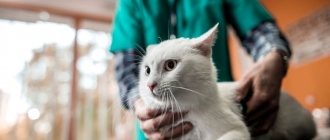- Causes of cancer in cats
- Types and stages of cancer in cats
- Symptoms of cancer in cats
- Diagnosis and treatment of cancer in cats
Cancer (malignant tumor) is the general name for a group of oncological pathologies characterized by uncontrolled growth and division of cells.
Without timely treatment, this disease is fatal as cancer cells invade surrounding tissues, compressing and damaging them. A malignant tumor disrupts the functioning of the organ in which it develops and releases toxins that poison the body. In this case, there is a strong weakening of the immune system and general physical exhaustion. Many pet owners are interested in whether cats get cancer. Yes, this most dangerous disease affects not only people, but also animals.
Causes of cancer in cats
The exact causes of malignant neoplasms in cats have not yet been clarified. Most veterinarians believe that it is living in close contact with humans and eating dry and canned food containing preservatives and other chemicals harmful to the animal’s body that cause cancer. After all, the main cause of cancer is generally considered to be DNA damage caused by various carcinogens. These substances affect the cell genome, causing mutations and uncontrolled reproduction.
Another version of the development of cancer in cats is infection of the animal with oncoviruses (there are more than 100 types). During normal functioning of the body's defenses, the vital activity of these viruses is neutralized by the immune system. If the immune system does not work well, the activity of oncoviruses leads to the development of malignant neoplasms.
Experts identify a number of predisposing factors that contribute to the occurrence of cancer:
- heredity;
- weak immunity;
- diseases of internal organs;
- low-quality feed;
- improper feeding;
- endocrinological disorders;
- frequent stress;
- exposure to radiation, poor environmental conditions.
The development of the disease does not depend on age. Malignant tumors are recorded both in young cats under one year old and in older animals. Most often, oncology is registered in cats after the age of five.
Types and stages of cancer in cats
Cancer cells can develop in any organ or tissue; most often in cats, lung cancer, skin cancer, intestinal cancer, stomach cancer, blood cancer, and mammary cancer (in older animals) are diagnosed.
There are four stages of development of the malignant process:
- first – the presence of a limited tumor nodule, metastases and severe symptoms are absent;
- second – the growth of the tumor continues, the cancer grows inside the organ and metastasizes to the nearest lymph nodes;
- third – tumor mobility decreases, the number of metastases increases;
- fourth - the process is irreversible, the cancer affects large areas and leads to the death of the cat.
Development of the disease
So, under the influence of certain factors, cell mutation occurs. Infected cells are characterized by uncontrolled division due to the destruction of cells of healthy tissue or organ of the body, which causes their destruction. In some cases, the mutation is transmitted to nearby areas and grows further.
Ultimately, cancer cells enter the lymph node and are carried along with the blood to distant areas of the body, where they grow at the expense of other healthy cells. This growth of cat cancer is called metastasis.
The word “cancer” refers to a malignant formation that causes a severe deterioration in the pet’s health until its death. Benign tumors are distinguished by the fact that they are not transferable to other areas of the body. It is easier and more effective to treat such formations.
Symptoms of cancer in cats
Symptoms of cancer in cats can be different, depending on the location of the malignant tumor:
- With lung cancer, cough, shortness of breath, and breathing problems are observed.
- For skin cancer - non-healing ulcers, bumps, swellings, most often on the nose, lips, inside the ears, in the genital area, between the fingers and on the pads.
- For intestinal and stomach cancer - sudden weight loss, anemia, poor appetite, drowsiness and general weakness, fever. With a stomach tumor, dark blood clots are visible in the stool; with intestinal cancer, foul-smelling stool with fresh scarlet blood is observed. Cancer of the gastrointestinal tract in cats is accompanied by chronic constipation/diarrhea and a putrid odor from the mouth.
- Blood cancer (leukemia) is considered a viral chronic malignant disease. The clinical picture is as follows: depression, poor appetite, impaired absorption of nutrients, vomiting, diarrhea, sudden weight loss, yellowness of the mucous membranes, respiratory failure.
Many owners are interested in whether it is possible to get cancer from a cat. The answer is clear - no. Even when cancer cells are transplanted into healthy tissue, infection does not occur.
Diagnosis and treatment of cancer in cats
Symptoms of cancer can also be observed in other diseases, so if malignant oncology is suspected, it is important to make a diagnosis in time. For this, modern diagnostic methods are used - ultrasound diagnostics, magnetic resonance imaging, computed tomography, X-rays, endoscopy, cytological and histological studies, blood tests.
Treatment methods for malignant tumors are determined by the type of formation and the stage of development of the process.
There are several main ways to treat cancer in cats:
- Surgical removal of a malignant tumor gives good results in the early stages.
- Chemotherapy is the introduction of special drugs into the animal’s body that inhibit the growth and division of cancer cells.
- Radiation therapy – kills malignant cells in a localized manner.
- Immunotherapy is used for all types of cancer; its main function is to activate the body’s defenses, since it is impossible to defeat a tumor without strengthening the immune system.
Based on an assessment of the animal’s condition, a comprehensive diagnosis of the disease and a diagnosis with determination of the stage of oncology, the veterinarian develops an individual treatment plan.
If a tumor has opened. Interview with a leading oncologist
One of the most common questions that pet owners ask oncologists on our clinic’s forum is the question of what to do if a cat’s tumor is discovered. It is impossible to cover all aspects of this problem in detail in a forum format, so we decided to discuss them with the leading oncologist of the Biocontrol clinic, Candidate of Biological Sciences Alexander Alexandrovich Shimshirt.
— The tumor has opened. What does this mean for a dog and what for a cat?
- If we are talking about a tumor that has opened, it doesn’t matter whether it’s in a cat or a dog - it’s almost always not good. But this is doubly bad for a cat, because cats are very clean animals. By nature, they do not like to leave their scent in the external environment.
When a cat develops a tumor, the animal instinctively tries to get rid of this smell by licking itself. Cats have a rough tongue and, accordingly, when the animal begins to perform the standard hygienic procedure of licking, it further injures the tumor. So in a cat the consequences of opening a tumor will develop faster and will be more uncomfortable than in a dog.
— What tumors behave like this, that is, they open up?
— For the most part, if we are talking about cats, these are tumors of the mammary glands. In dogs these are skin tumors. Tumors that are actively opening include tumors of the oral cavity and mucous membranes. Tumors can open in the oral cavity when they are actively growing or due to mechanical trauma when eating food.
- Is it all cancer?
- Most often it is just cancer: epithelial tumors, tumors of the skin, mucous membranes. If mammary gland tumors are large, they begin to adhere to the skin; therefore, either inflammation occurs, or the tumor is mechanically injured by the animal and licks into an ulcer. Or, against the background of actively occurring necrosis processes, a surface defect is formed, which, due to contact with the external environment and the surrounding microflora, begins to become even more inflamed.
— Can any benign neoplasms behave like this?
- Most often not. Because the presence of an ulcer is a sign of either rapid growth or inflammation. And rapid growth and inflammation are signs uncharacteristic of benign tumors.
Another point is that some skin tumors can open and they are considered malignant from the point of view that, having opened, they can, due to the inflammatory component, produce a large amount of inflammation with the elimination of tumor cells in the surrounding tissues, and if the doctor’s attitude is inadequate when removing the tumor relapse may occur in this area. Therefore, they are malignant due to the ability to recur. At the same time, metastasis in a number of skin tumors that have opened, for example, in basal cell carcinoma, which occurs in both cats and dogs, occurs quite slowly and rarely. Therefore, the revealed tumor of the revealed tumor is discord. There are situations when the formation can exist for a long time, for example, a tumor of the hair follicle (sebaceous gland). Then it becomes inflamed, then it opens and the contents of the tumor come out. Then the surface is again covered with scar tissue and then waits until the formation again increases in size and becomes inflamed again.
But in general, it is believed that the fact of inflammation and the presence of ulcers is already a negative sign that requires emergency action: going to the doctor, prescribing antibiotics, anti-inflammatory drugs, and in most cases, surgical excision in the near future. Because the presence of an ulcer is a manifestation of inflammation; inflammation is a factor in subsequent rapid growth and, as a rule, ulceration, and most often malignant tumors that can metastasize are ulcerated.
— Is it correct to say that opening a tumor is primarily a sign that the owner has neglected his animal? Why did he bring his pet to such a state?
— The question is very difficult. After all, the owners are not doctors and perceive some things in an ordinary format. Well, bump and bump, it doesn’t grow and doesn’t grow. And if the animal also has a lot of hair, then the bump is difficult to notice. Especially in cats, which sometimes do not like active bodily contact and do not often allow their owners to actively examine and feel them. Moreover, tumors of the mammary glands located on the abdomen are most often opened. The animal instinctively protects its stomach, this is how nature instituted it, so that the animal can preserve its life, its internal organs. Therefore, an examination of the abdominal wall by the owner is, let’s say, an unpleasant procedure for a cat.
With a dog, everything is simpler, because dogs are more focused on tactile contact with the owner, they are more willing to allow themselves to be examined. But, of course, a lot depends on the owner. There are very attentive people who find neoplasms of minimal size in their pets, which are difficult for even a doctor to find during an initial examination. Therefore, there is, of course, some truth in the fact that this inattention to the animal exists. But I would not say this categorically.
— When the tumor opens, what to do about it?
— First of all, if it is not possible to show your pet to a doctor, you need to carry out the usual standard hygienic treatment of the tumor. If there is fur in this area, you should try to shave or clip it. Then evaluate the nature of the expiration. If this discharge is bloody, and the blood clots after some time on the surface, then this is active bleeding - you need to see a doctor urgently. If this is bloody discharge, then you have the opportunity to choose a convenient time to see a doctor. But, of course, without delaying the visit for long.
The owner's arsenal should include standard antiseptic solutions that are used to treat the skin. For mucous membranes it is better to use solutions of chlorhexidine 0.05%, miramistin, furatsilin. After treatment, it is advisable to put on a protective bandage, a bandage and a protective collar for the animal, especially if the animal tries to lick the wound.
— So you have now listed the preparatory measures in order to deliver the animal to the clinic? Why can’t you help an animal at home yourself, without going to a doctor? The fact is that there are a lot of topics and forums on the Internet where people advise each other how to treat these tumors: Vishnevsky ointment, various lotions and poultices, and so on.
— If we are talking about a tumor and not an abscess, then the use of ointments that have a warming effect can lead to the inflammation becoming even greater. There will be more blood flow, the tumor will grow faster and, of course, in an indirect way, but a more active spread of the malignant process may occur. With an actively growing tumor, such a sad scenario is possible. Therefore, self-medication usually ends in serious problems.
If we are talking about a malignant process, then it is necessary to consult a veterinarian and, best of all, with a certain specialization. This should be either a surgeon or an oncologist, that is, a specialist who can adequately advise how to behave in this situation. The doctor will be able to perform surgical treatment, recommend surgery and some additional therapy: antibiotic therapy, for example, until the issue of surgical removal of the opened lesion is resolved in the animal. Because for the most part, revealed tumors require surgical removal, and as soon as possible.
— What are the features of operations to remove such tumors?
“First of all, such formations should not be enucleated, that is, only the tumor itself should not be removed. According to the rules of oncological surgery, they must be removed, taking into account the surrounding tissues, taking into account their anatomical location, taking into account the blood and lymph circulation in this area. This means that it is better to contact a qualified oncologist or surgeon to ensure that this formation is excised correctly and to reduce the likelihood of relapse and further spread of the tumor.
Surgical intervention for tumors in animals is not considered in terms of simple surgical excision alone. Such important points are assessed as, firstly, whether this excision will improve the quality of life of the animal, and secondly, whether the animal will continue to live adequately, whether it will be mobile after the operation and how long the rehabilitation period will be. All these points are taken into account by the oncologist surgeon. If he considers the intervention appropriate, if there is a possibility that this intervention will be successful, it is carried out. If this intervention is crippling, if it does not improve the quality of life of the animal, or if the prognosis is unfavorable, then there is no question of surgery.
— What to do if it is not advisable to perform the operation or it is simply too late? For example, due to age, general condition of the patient, presence of metastases?
— If, based on objective data, a decision is made that it is impossible to improve the patient’s quality of life with surgical intervention, then palliative therapy is possible. Most often, it involves the choice of local treatments, antibiotic therapy, and a course of anti-inflammatory drugs. Regular monitoring of the animal's condition is also important. No one gives up on such patients. If they cannot be helped surgically, then it is possible to at least alleviate their condition. Clinical cases are very different.
— Recovery of the animal after surgery. How is this period going?
— It all depends on the volume of the operation. If we are talking about the removal of large tumors, then sometimes plastic surgery is required, and it even happens that this reconstructive surgery takes place in several stages. Of course, the recovery period can be long.
— And another question, most likely rhetorical. What to do to never encounter such a situation as opening a tumor?
— Speaking rhetorically, I must say that, unfortunately, over time no one becomes younger and healthier. And neoplasms, as a rule, do not tend to decrease, but tend to increase. Therefore, all pets, and especially older dogs and cats, require regular examination in the format of medical examination.
Any neoplasm, especially in an older animal, must be treated carefully. It is imperative to find out what the nature of the formation is in order to develop an approach and tactics on how to deal with it in a particular scenario. The earlier a problem is detected, the higher the likelihood of its solution. This will not only save the life and health of the pet, but will also save time and money for its owner.











